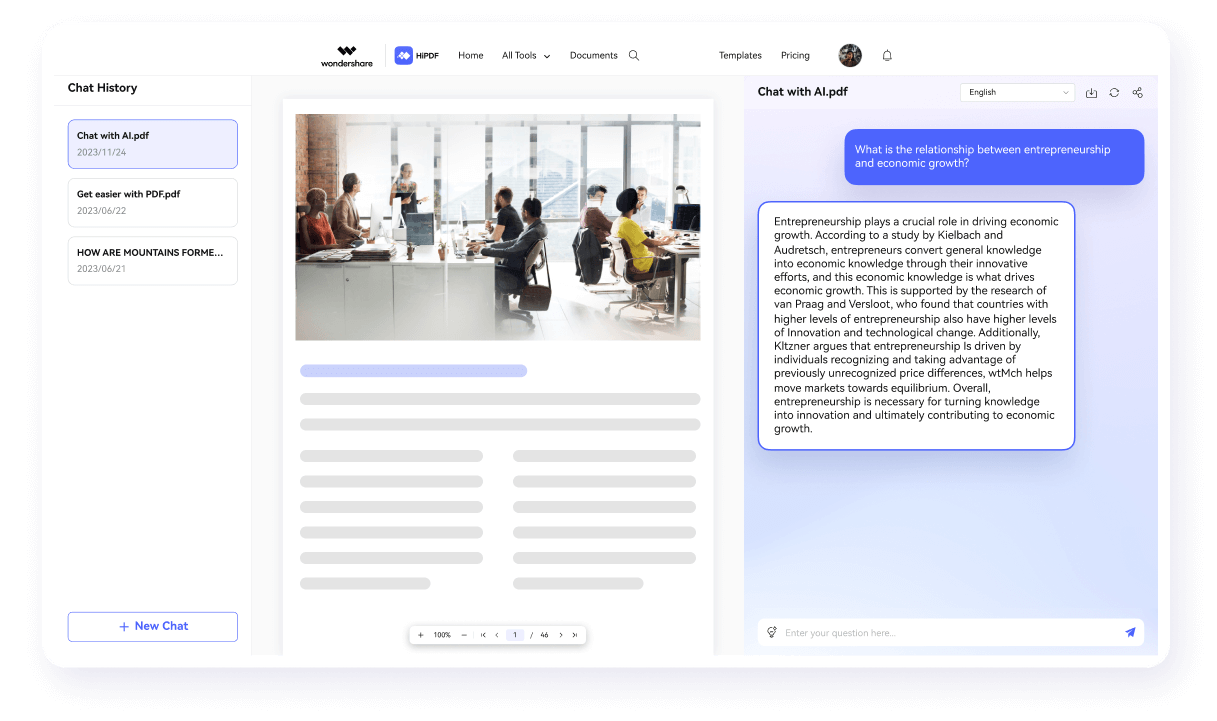In today’s digital age, the way we handle documents has evolved significantly. One such evolution is the ability to “chat with PDF,” a term that refers to interacting with and annotating PDF documents to facilitate communication and collaboration. This concept has become increasingly important as more people and organizations shift to digital workflows. Whether for educational purposes, professional communication, or personal use, chatting with PDFs offers numerous advantages. This article explores what it means to chat with PDFs, the benefits, tools and software available, practical steps, tips, challenges, real-world examples, future trends, and additional resources to help you make the most of this innovative approach.
Benefits Of Chatting With PDFs
Enhanced Collaboration And Communication
One of the primary benefits of chatting with PDFs is the enhanced collaboration it offers. By allowing multiple users to add comments and annotations, it facilitates better communication. This is particularly useful in team settings where feedback from various members can be compiled in one place, making the review process more efficient.
Easy Sharing And Accessibility
PDFs are universally accessible and can be opened on virtually any device with a PDF reader. This makes sharing documents straightforward and ensures that all collaborators can view and interact with the document regardless of their device or operating system. Additionally, cloud-based PDF tools allow real-time collaboration, further enhancing accessibility.
Maintaining Document Integrity And Format
Unlike other document formats, PDFs maintain their formatting across different devices and platforms. This ensures that the document’s layout, fonts, and images remain consistent, providing a reliable reference point for all users. Annotations and comments can be added without altering the original content, preserving the document’s integrity.
Improved Productivity And Efficiency
Chatting with PDFs can significantly boost productivity. By centralizing comments and feedback within the document, users can quickly address issues and make necessary changes. This reduces the need for lengthy email threads and meetings, streamlining the workflow and allowing for faster project completion.
Tools And Software For Chatting With PDFs
Adobe Acrobat
Adobe Acrobat is one of the most popular tools for working with PDFs. It offers a comprehensive set of features for chatting with PDFs, including adding comments, highlighting text, and drawing shapes. Users can also track changes and view comment history, making it easier to follow the discussion.
PDFescape
PDFescape is a web-based tool that provides essential PDF editing and annotation features. It allows users to add text, comments, and annotations to PDFs without needing to download any software. This makes it a convenient option for quick edits and collaborative work.
Foxit PDF Editor
Foxit PDF Editor is another powerful tool for PDF collaboration. It offers advanced features like document comparison, form creation, and digital signatures. Foxit also supports real-time collaboration, enabling users to work together on documents simultaneously.
Other Relevant Applications
Other tools worth mentioning include Nitro PDF, Smallpdf, and PDF-XChange Editor. Each of these offers unique features and benefits, catering to different user needs. Whether you’re looking for advanced editing capabilities or simple annotation tools, there’s a solution available to fit your requirements.
How To Chat With PDFs: Step-By-Step Guide
Selecting The Right Tool For Your Needs
The first step in Chat with pdf is choosing the right tool. Consider your specific needs, such as the level of collaboration required, the complexity of the document, and the budget. Popular options include Adobe Acrobat for comprehensive features, PDFescape for simplicity, and Foxit PDF Editor for advanced editing.
Importing And Opening The PDF
Once you’ve selected your tool, the next step is to import and open the PDF. Most tools allow you to upload documents directly from your computer or cloud storage services like Google Drive and Dropbox. Ensure the document is correctly opened and ready for annotation.
Adding Comments And Annotations
Adding comments and annotations is the core of chatting with PDFs. Use the tool’s commenting features to highlight text, insert notes, and draw shapes. Be clear and concise in your comments to ensure they are easily understood by other collaborators. Organize your annotations logically, focusing on specific sections of the document.
Using Chat Features (If Available)
Some PDF tools offer chat features that allow real-time communication within the document. These can be particularly useful for collaborative projects, enabling team members to discuss changes and provide feedback instantly. Utilize these features to enhance communication and streamline the review process.
Saving And Sharing The PDF
After adding your comments and annotations, save the document to preserve your changes. Use the sharing options provided by the tool to distribute the PDF to other collaborators. Ensure that all stakeholders have access and can contribute to the document as needed.
Tips For Effective PDF Communication
Clear And Concise Annotations
To ensure your annotations are helpful, keep them clear and concise. Avoid long-winded comments and focus on specific points that need attention. Use highlights and shapes to draw attention to important sections.
Organizing Comments For Better Readability
Organize your comments logically to enhance readability. Group related comments together and use headings or labels to indicate different sections. This helps collaborators follow the discussion more easily.
Ensuring Document Security And Privacy
When sharing PDFs, it’s important to ensure the document’s security and privacy. Use password protection and encryption features to safeguard sensitive information. Only share the document with trusted collaborators and monitor access permissions.
Regularly Updating The Document For Collaboration
For ongoing projects, it’s crucial to keep the document updated. Regularly review and incorporate feedback, making necessary changes to reflect the latest discussions. This ensures that all collaborators are working with the most current version.
Common Challenges And Solutions
Handling Large PDF Files
Large PDF files can be challenging to work with, especially when multiple annotations are involved. To manage this, consider compressing the file size using PDF tools that offer compression features. Additionally, split the document into smaller sections if necessary.
Dealing With Compatibility Issues
Compatibility issues can arise when different users are using different PDF tools. To mitigate this, choose a universally accepted tool like Adobe Acrobat and ensure all collaborators are using compatible software. Alternatively, use web-based tools that eliminate compatibility concerns.
Managing Multiple Comments And Annotations
Managing numerous comments and annotations can become overwhelming. Use the filtering and sorting features available in most PDF tools to organize and prioritize feedback. This helps keep the document manageable and ensures that all comments are addressed.
Real-World Examples And Case Studies
Examples Of Educational Settings Using PDF Chats
In educational settings, teachers can use PDF chats to provide detailed feedback on student assignments. For instance, a teacher might highlight sections of an essay and add comments suggesting improvements. This method allows for clear and structured feedback, helping students understand and implement changes effectively.
Business Scenarios Where PDF Communication Is Beneficial
In the business world, PDF communication can streamline the review process for reports and proposals. For example, a team working on a marketing proposal can use PDF tools to add comments and suggestions directly on the document. This centralized approach ensures all feedback is visible and can be addressed efficiently.
Personal Use Cases And Success Stories
On a personal level, PDF chatting can be useful for planning events or managing projects. For instance, when planning a wedding, the couple can share a PDF of the itinerary with family members, who can then add comments and suggestions. This collaborative approach ensures everyone is on the same page and can contribute to the planning process.
Future Trends In PDF Communication
Emerging Technologies And Advancements
The field of PDF communication is continuously evolving, with emerging technologies enhancing the way we interact with documents. Artificial intelligence (AI) and machine learning are being integrated into PDF tools, providing features like automated suggestions and improved document analysis.
The Role Of AI And Machine Learning In Enhancing PDF Chats
AI and machine learning can significantly enhance PDF chats by offering intelligent features such as automated summarization of comments, predictive text, and context-aware suggestions. These advancements can make the annotation process more efficient and reduce the time spent on manual tasks.
Predictions For The Future Of PDF Communication
The future of PDF communication looks promising, with continued advancements in technology leading to more seamless and efficient collaboration. We can expect more robust integration with other digital tools, enhanced real-time collaboration features, and improved security measures to protect sensitive information.
Conclusion:
Chatting with PDFs is a powerful method for enhancing collaboration and communication across various settings. Whether for educational purposes, professional use, or personal projects, the ability to annotate and comment on PDFs offers numerous benefits. By choosing the right tools, following best practices, and staying updated with emerging trends, you can make the most of this innovative approach. Embrace the power of PDF communication to streamline your workflows and enhance your productivity.


